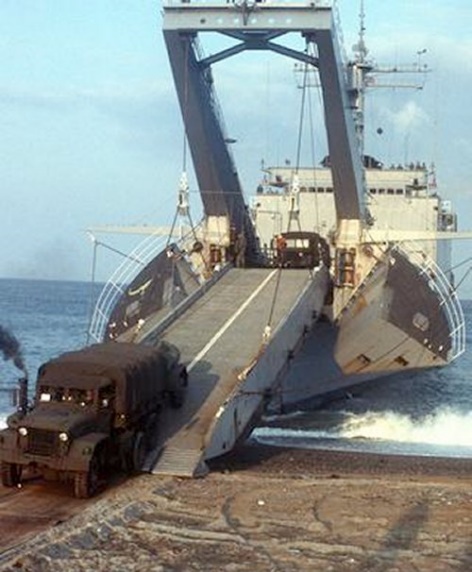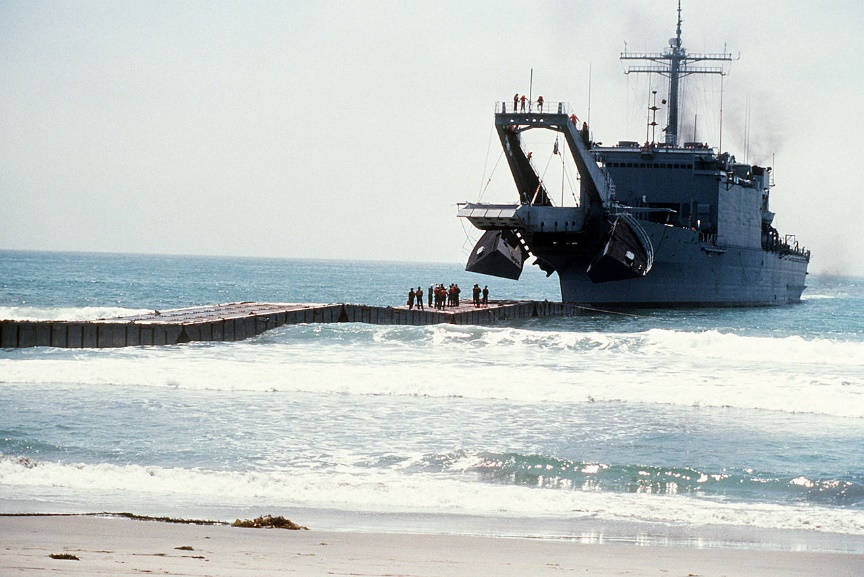Amphibious ships
The core capability of an amphibious force, that of delivering combat power to contested shores falls on its ships. Once on land the ground and air elements take over the heavy fighting, but they need to get ashore in a coherent combat ready fashion to have the effect needed.
The US Navy (USN) has the largest and most modern collection of amphibious ships on the planet (The Gator Navy). Although not enough of these ships exist to satisfy the strategic requirement, they are very impressive ships an together form a formidable force. The Gator Navy consists of a multitude of ship types and capabilities. Some of which are listed here:
LHD: Landing Helicopter Dock. These extremely capable ships of the Wasp Class are the largest and most capable Amphibious ships in the world. Capable of hosting AV-8B Harriers, helicopters and having a docking bay for landing craft or the LCAC (Landing Craft Air Cushioned) or hovercraft, one of these ships is capable of carrying 1800 Marines and a full Battalion worth of equipment. At 40,000 tons, these exceptionally flexible ships displace as much or more then most World War Two Battleships and all war era aircraft carriers except the IJN Shinano (which only survived a few days).
Historically only three of these ships were commissioned by 1994, however due to increased tensions in Northern Fury the original schedule was maintained and there were two additional hulls available – LHD-5 Bataan joining the fleet at the end of Jan 1994, only two weeks old at war start. The next ship of this class to joint the fleet will be in mid 1995.
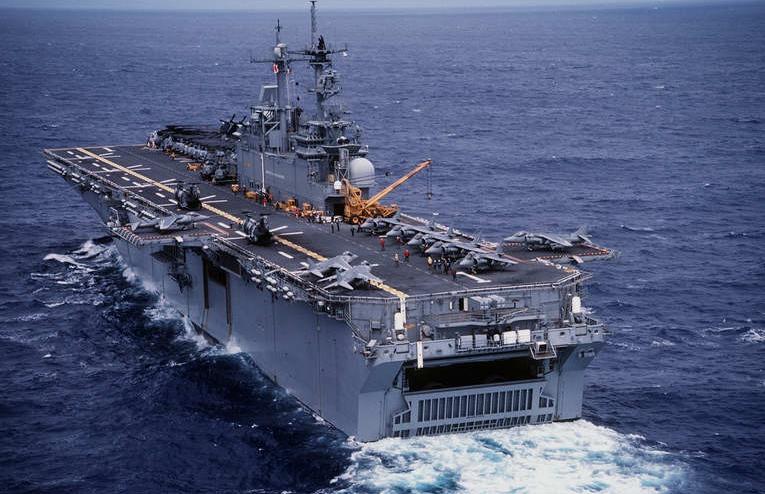
LHD-1 USS Wasp
| Pennant | Name | Date | Fleet | Home Port | Task |
|---|---|---|---|---|---|
| LHD-1 | Wasp | Jul-89 | Atlantic | Norfolk | 6th Mar Regt |
| LHD-2 | Essex | Oct-92 | Pacific | San Diego | |
| LHD-3 | Kearsarge | Jun-93 | Atlantic | Norfolk | Med 22 MEU |
| LHD-4 | Boxer | Oct-93 | Pacific | San Diego | |
| LHD-5 | Bataan | Jan-94 | Atlantic | Norfolk | 8th Mar Regt |
LHA: Landing Helicopter Assault. The predecessors to the Wasp class are the Tarawa Class LHA. These ships, while almost as capable as the LHD, but are 10 years older both in design and in technology, each is capable of conducting the same operations but the LHA has a few more limitations. These are still very fine ships and among the best in the world. Of the nine ships originally planned only five were built.
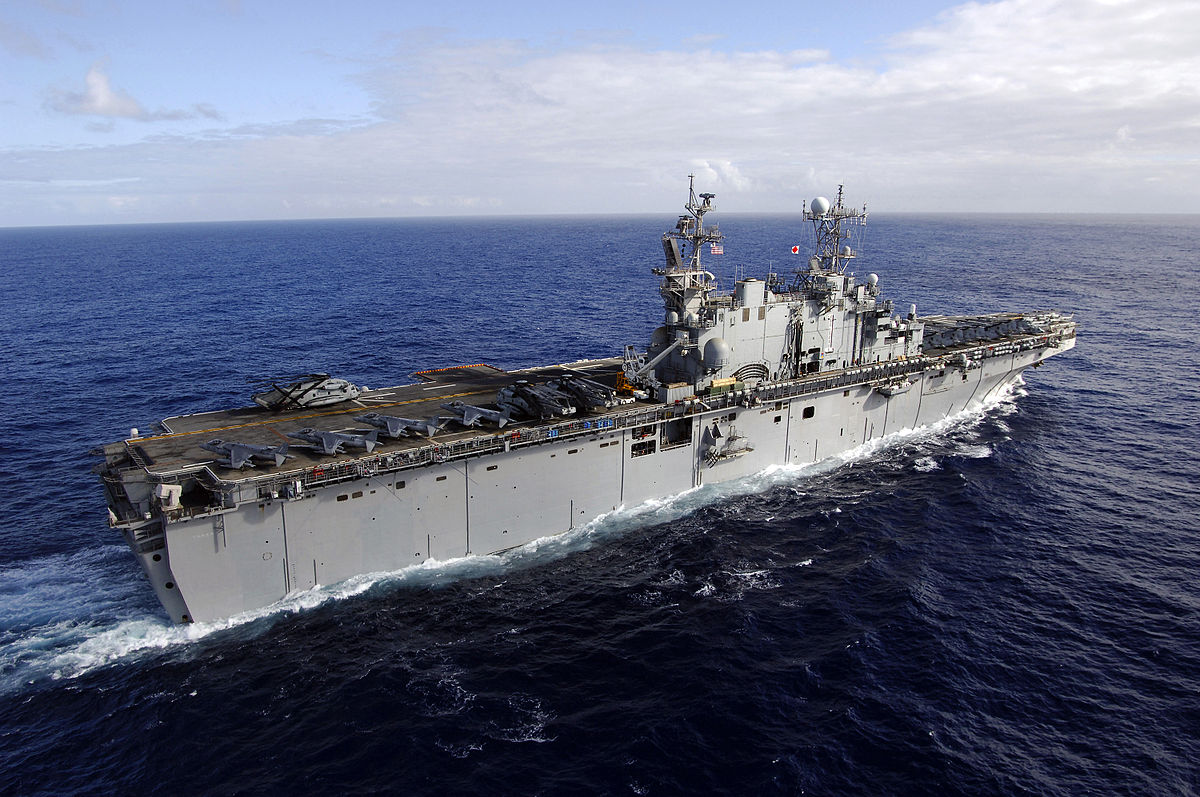
LHA-1 USS Tarawa
| Pennant | Name | Fleet | Home Port | Task | |
|---|---|---|---|---|---|
| LHA-1 | Tarawa | Pacific | San Diego | ||
| LHA-2 | Saipan | Atlantic | Norfolk | 8th Mar Regt | |
| LHA-3 | Belleau Wood | Pacific | Sesebo Japan | ||
| LHA-4 | Nassau | Atlantic | Norfolk | 6th Mar Regt | |
| LHA-5 | Peleliu | Pacific | San Diego | Indian Ocean 13 MEU |
LPH: Landing Platform Helicopter. The first dedicated post World War Two large Amphibious Assault ships were the Iwo Jima Class LPH. Only half the displacement of the Tarawa class, these ships have the same task of carrying up to 1800 Marines, however they can only carry a small fraction of the cargo, and do not have a well deck, therefore cannot deploy an LCAC and can only host about half the air group of the larger ships. These ships are approaching retirement age, having been launched in the 60’s but were maintained in the fleet due to the heightened threat. The seven ships in this class are not sequentially numbered.

LPH-2 USS Iwo Jima
| Pennant | Name | Fleet | Home Port | Task |
|---|---|---|---|---|
| LPH-2 | Iwo Jima | Atlantic | Norfolk | 6th Mar Regt |
| LPH-3 | Okinawa | Pacific | San Diego | Refit |
| LPH-7 | Guadalcanal | Atlantic | Norfolk | 2 MEF |
| LPH-9 | Guam | Atlantic | Norfolk | 2 MEF |
| LPH-10 | Tripoli | Pacific | Persian Gulf | MCMG |
| LPH-11 | New Orleans | Pacific | San Diego | |
| LPH-12 | Inchon | Atlantic | Norfolk | 8th Mar Regt |
LPD: Landing Platform Dock. There are two main classes of these smaller amphibious ships. The Raleigh class of two ships was due to retire in the early 90’s but were retained. The Austin class of eleven, with three sub classes, the Cleveland sub-class (7 ships) with an additional space and communications to be a Flagship and the Trenton sub-class (2 ships) with updated systems, all are effectively the same. These ships house about 850 Marines and good amount of heavy equipment, and are often used to carry heavy loads such as the tanks with landing craft Mechanized (LCM) to unload them. They are capable of independent operations and when part of an ARG/ESG will often be detached to conduct separate duties. It is worth noting that one Raleigh class and one Austin class were modified to be command ships (AGF-3 La Salle, and AGF-11 Coronado).
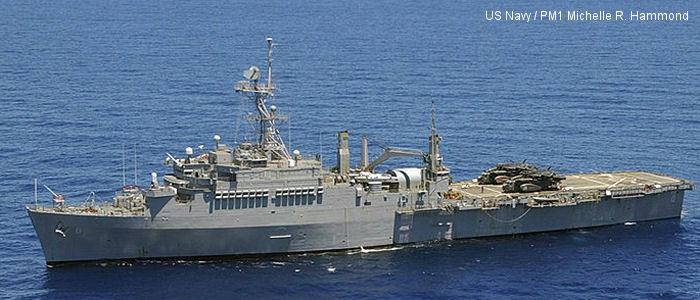
LPD 6 USS Duluth
| Pennant | Name | Fleet | Home Port | Task |
|---|---|---|---|---|
| LPD-1 | Raleigh | Atlantic | Norfolk | 6th Mar Regt |
| LPD-2 | Vancouver | Pacific | San Diego | |
| LPD-4 | Austin | Atlantic | Norfolk | 8th Mar Regt |
| LPD-5 | Ogden | Pacific | San Diego | |
| LPD-6 | Duluth | Pacific | San Diego | |
| LPD-7 | Cleveland | Pacific | San Diego | Indian Ocean 13 MEU |
| LPD-8 | Dubuque | Pacific | San Diego | |
| LPD-9 | Denver | Pacific | San Diego | |
| LPD-10 | Juneau | Pacific | Sasebo Japan | |
| LPD-12 | Shreveport | Atlantic | Norfolk | 6th Mar Regt |
| LPD-13 | Nashville | Atlantic | Norfolk | Med 22 MEU |
| LPD-14 | Trenton | Atlantic | Norfolk | 6th Mar Regt |
| LPD-15 | Ponce | Atlantic | Norfolk | 8th Mar Regt |
LSD: Landing Ship Dock. Although very similar in appearance and size to the LPD; the LSD’s primary purpose is to transport landing craft and LCACs, it only holds half the Marines of an LPD and much less heavy equipment and cargo. An enormous docking bay enables them to house up to 4 LCACs. Of the three classes in service, LSD-36 Anchorage (5 ships) is the smallest, holding 3x LCACs, LSD-41 Whidbey Island (8 ships) can hold 4x LCAC, while the newest class being rushed into service, LSD-49 Harpers Ferry can only hold 2x LCACs but 10 times the cargo of the others.
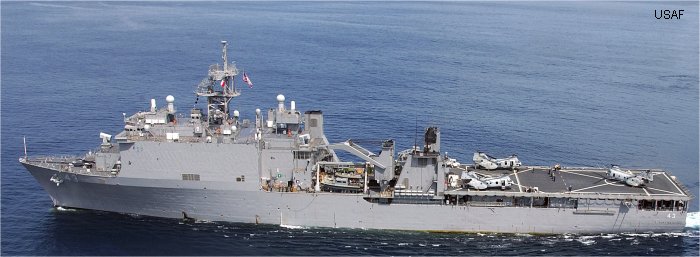
LSD-41 Whidbey Island
| Pennant | Name | Fleet | Home Port | Task |
|---|---|---|---|---|
| LSD-36 | USS Anchorage | Pacific | San Diego | |
| LSD-37 | USS Portland | Atlantic | Little Creek | 8th Mar Regt |
| LSD-38 | USS Pensacola | Atlantic | Little Creek | 8th Mar Regt |
| LSD-39 | USS Mount Vernon | Pacific | San Diego | Indian Ocean 13 MEU |
| LSD-40 | USS Fort Fisher | Pacific | San Diego | |
| LSD-41 | Whidbey Island | Atlantic | Little Creek | 6th Mar Regt |
| LSD-42 | Germantown | Pacific | Japan | |
| LSD-43 | Fort McHenry | Atlantic | Little Creek | 6th Mar Regt |
| LSD-44 | Gunston Hall | Atlantic | Little Creek | 6th Mar Regt |
| LSD-45 | Comstock | Pacific | San Diego | |
| LSD-46 | Tortuga | Atlantic | Little Creek | Med 22 MEU |
| LSD-47 | Rushmore | Pacific | San Diego | |
| LSD-48 | Ashland | Pacific | Japan | |
| LSD-49 | Harpers Ferry | Pacific | San Diego | |
| LSD-50 | Carter Hall | Atlantic | Little Creek | 8th Mar Regt |
LST: Landing Ship Tank. The smallest amphibious ship in the USN, these are much improved decedents of the famous LSTs that landed on the beaches of Normandy and virtually every other beach assaulted by the Allies in World War Two. These ships carry up to 29 tanks and 350 Marines, they’re the only ships that approach the shore and are able to lay down a ramp to unload over its bow directly onto the beach or dock, or open a loading gate in the stern of the ship, allowing a chain of LSTs to form a floating causeway for larger ships unloading by ramp into the stern and driving through the LST onto the beach. Unloading by helicopter or crane onto a dock or small boats is also workable.
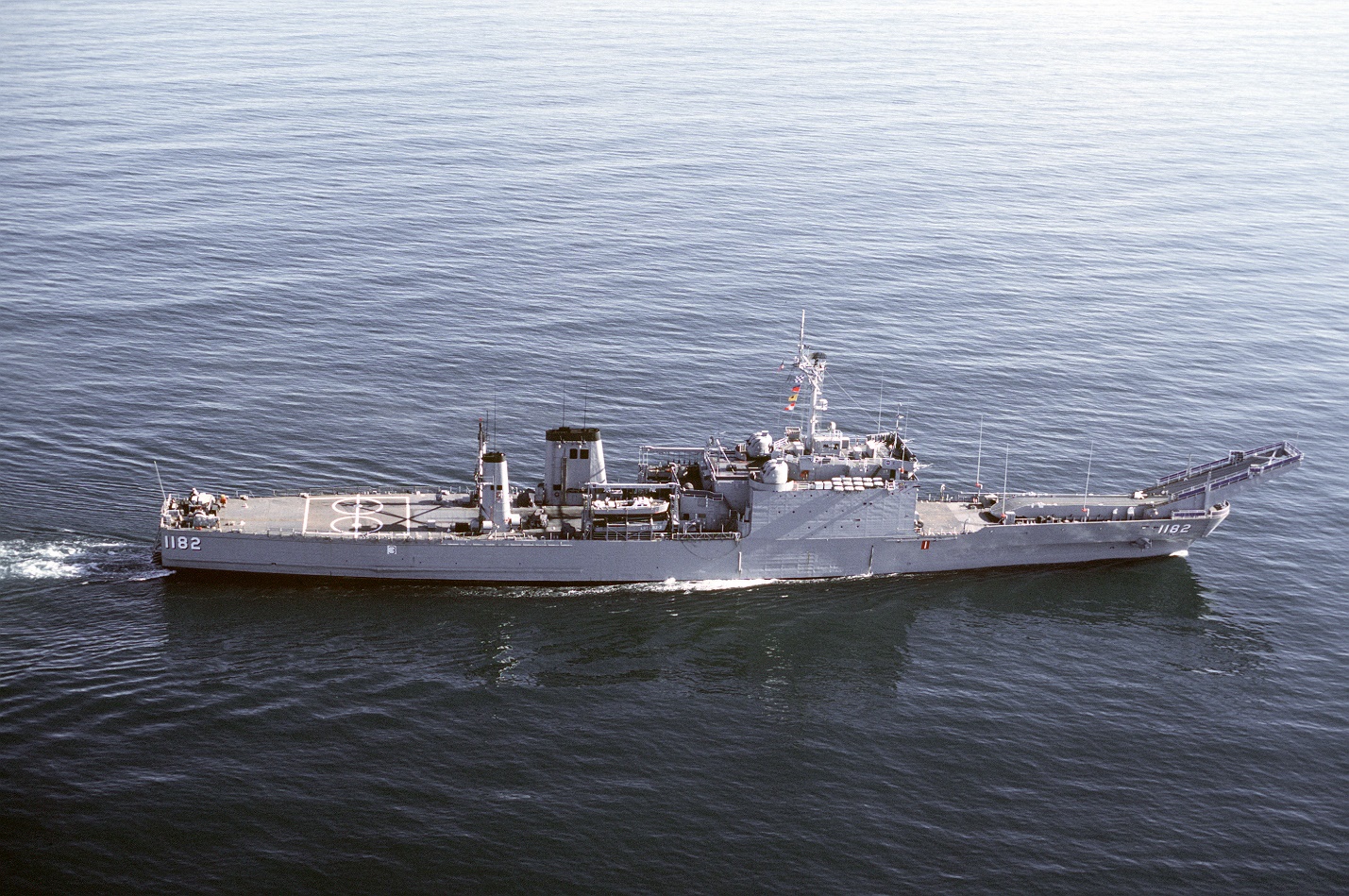
LST 1182 USS Fresno
| Pennant | Name | Fleet | Home Port | Task |
|---|---|---|---|---|
| LST-1179 | Newport | Atlantic | Little Creek | 8th Mar Regt |
| LST-1180 | Manitowoc | Atlantic | Little Creek | 8th Mar Regt |
| LST-1181 | Sumter | Atlantic | Little Creek | Mediterranean |
| LST-1182 | Fresno | Pacific | San Diego | |
| LST-1183 | Peoria | Pacific | San Diego | Philippines |
| LST-1184 | Frederick | Pacific | Pearl Hbr | |
| LST-1185 | Schenectady | Pacific | San Diego | |
| LST-1186 | Cayuga | Pacific | San Diego | Standby off Mogadishu |
| LST-1187 | Tuscaloosa | Pacific | San Diego | Australia |
| LST-1188 | Saginaw | Pacific | San Diego | |
| LST-1189 | San Bernardino | Pacific | San Diego | Philippines |
| LST-1190 | Boulder County | Atlantic | Little Creek | 8th Mar Regt |
| LST-1191 | Racine | Atlantic | Little Creek | 8th Mar Regt |
| LST-1192 | Spartanburg County | Atlantic | Little Creek | 6th Mar Regt |
| LST-1193 | Fairfax County | Atlantic | Little Creek | 6th Mar Regt |
| LST-1194 | La Moure County | Atlantic | Little Creek | 6th Mar Regt |
| LST-1195 | Barbour County | Pacific | San Diego | Transit to Mogadishu |
| LST-1196 | Harlan County | Atlantic | Little Creek | 6th Mar Regt |
| LST-1197 | Barnstable County | Atlantic | Little Creek | Caribbean |
| LST-1198 | Bristol County | Pacific | San Diego | Mediterranean |
